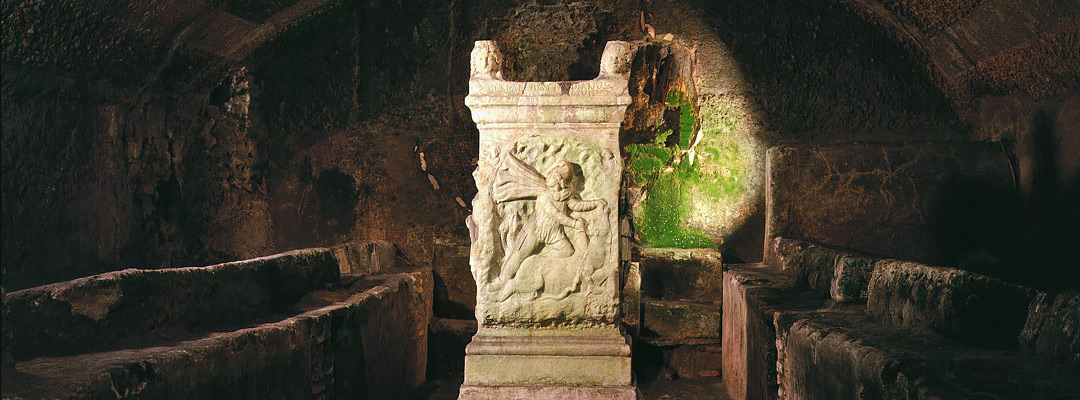Mithras and Eastern Religion on Hadrian’s Wall
How a remarkable sculpture of Mithras, found at the remote frontier fort of Housesteads on Hadrian’s Wall, reveals religious and military connections with distant parts of the Roman Empire.

A SECRETIVE CULT
In 1822, when excavators were working at Housesteads, they discovered an extraordinary stone sculpture. Other finds in the same area revealed that it depicted the god Mithras, and that the excavators had found a temple dedicated to him. Several features of the sculpture are unique, and offer an eerie insight into a mysterious and secretive cult that was favoured by high-ranking Roman army officers.
Mithras was originally a Persian deity, eternally at war with evil. According to legend he captured a bull – symbolic of primeval force and vitality – and slew it in a cave, to release its concentrated power for the good of mankind.
When the cult was brought to the Roman Empire from the east, by the army and traders, it came to focus on the figure of Mithras himself, as the saviour of his followers. Among his devotees, army officers on the frontiers loomed large.
DARK RITUALS
Mithraic temples were small, gloomy, semi-subterranean structures, intended to evoke the legendary cave where Mithras killed the bull. Inside, secret ceremonies would be followed by ritual feasts, the devotees reclining on benches running along the side walls.
Fragments of a relief of the bull-slaying scene were found when the Housesteads Mithraeum was excavated.
BIRTH SCENE
But the stone sculpture depicting the birth of the god was the most striking discovery. It shows Mithras emerging from an egg, rising naked from the lower part of an eggshell while the upper half of the shell caps his head; surrounding him is an egg-shaped zodiac representing the cosmos.
Several elements make the sculpture unique. First, in birth scenes, Mithras usually springs from a rock. The egg-birth and surrounding signs of the zodiac show that at Housesteads he has been fused with other gods: the Orphic Phanes, born from an egg as first ruler and creator of all, and Aion, god of time, usually depicted as a youth standing in a wheel bearing the signs of the zodiac. Secondly, the altars found in the temple were dedicated to Mithras Saecularis – ‘Mithras, Lord of this Age’.
This combination of gods and concepts must have seemed particularly powerful. The fact that it is found nowhere else also shows that someone with extensive learning and advanced religious and philosophical ideas led the Mithraic cult at Housesteads.
A SERIOUS MAN
This can have been none other than one Litorius Pacatianus, who dedicated the earliest altar in the Housesteads Mithraeum and was probably responsible for the ensemble of the bull-killing scene, birth scene and other sculptures, which are of the same kind of stone as his altar. The altar inscriptions show that he was a beneficiarius consularis, an army officer serving on the staff of the provincial governor, and evidently based at Housesteads for a time in the early 3rd century AD.
His origins are unknown, but he would have come from the Mediterranean area, quite possibly the east. Another altar in the Mithraeum is dedicated to Sol – the sun – by an easterner called Herion, apparently not a high-ranking officer or official. It has been suggested that he may have been a slave acquired by Pacatianus in an eastern province, where such advanced religious concepts were more widespread than in Britain.
That Litorius Pacatianus found time to indulge his sophisticated philosophical leanings, bequeathing this unique depiction of the birth of Mithras, is a striking insight into the lives of officers and officials on Hadrian’s Wall.
The Housesteads Mithraeum is no longer visible, but a completely excavated and finely preserved example can be visited at Carrawburgh on Hadrian’s Wall. The altars and sculptures from both Mithraea, including the Housesteads bull-slaying scene and the birth of Mithras, are displayed in the Great North Museum: Hancock, Newcastle upon Tyne.
By Nick Hodgson